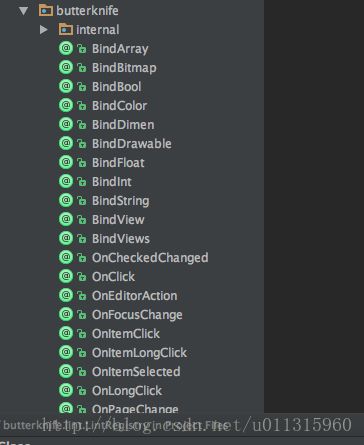前言#
我们已经把基本知识都搞定了,也能够实现简单的功能。作为这个系列的最后一篇,我们来看看Butterknife的实现原理。
Butterknife 的Github下载地址:https://github.com/JakeWharton/butterknife
正文#
运行Demo也在下载的包中,大家自己运行看下效果就可以了。首先我们来看看整个工程的结构:
下载的源码中的工程还是不少的,但是图中被选中的蓝色工程才是我们分析的重点,其他的三个光看名字可以推断出,是给gradle和lint工具使用的,这里就不做介绍了。
除了sample,其他的三个都是库,是不是觉得这个命名规则看上去十分熟悉,跟我们的demo很像,这样分析起来就容易多了,来看看Annotation中都有哪些注解:
卧槽槽,好多的注解,看名称我们就明白注解的作用,所以直接就找BindView,弄懂了一个,其他的也迎刃而解。
BindView源码:
/**
* Bind a field to the view for the specified ID. The view will automatically be cast to the field
* type.
*
* {@literal @}BindView(R.id.title) TextView title;
*
*/
@Retention(CLASS) @Target(FIELD)
public @interface BindView {
/** View ID to which the field will be bound. */
@IdRes int value();
}
一个资源id的value值,跟我们的没有什么区别,那就直接打开compiler,看看里面的Processor到底做了什么。
ButterKnife的代码还是不少,主要是看process方法:
@Override
public boolean process(Set elements, RoundEnvironment env) {
// 重点看这里
Map bindingMap = findAndParseTargets(env);
// 循环输出生成的文件
for (Map.Entry entry : bindingMap.entrySet()) {
TypeElement typeElement = entry.getKey();
BindingSet binding = entry.getValue();
JavaFile javaFile = binding.brewJava(sdk);
try {
javaFile.writeTo(filer);
} catch (IOException e) {
error(typeElement, "Unable to write binding for type %s: %s", typeElement, e.getMessage());
}
}
return false;
}
ButterKnife 封装的还是很仔细的,上面的代码主要是for循环输出编译出来的文件,对注解的操作都在 findAndParseTargets(env)这个方法里,那就去看看这个方法:
private Map findAndParseTargets(RoundEnvironment env) {
Map builderMap = new LinkedHashMap<>();
Set erasedTargetNames = new LinkedHashSet<>();
scanForRClasses(env);
...
// 重点看这里
// Process each @BindView element.
for (Element element : env.getElementsAnnotatedWith(BindView.class)) {
// we don't SuperficialValidation.validateElement(element)
// so that an unresolved View type can be generated by later processing rounds
try {
// 重点看这里
parseBindView(element, builderMap, erasedTargetNames);
} catch (Exception e) {
logParsingError(element, BindView.class, e);
}
}
...
return bindingMap;
}
这个方法里是处理各种注解的主方法,多余的我都删掉了,这个方法主要是获取所有的注解,然后解析注解,把注解的所有信息封装到BindingSet中,那么解析的具体操作应该就在parseBindView(element, builderMap, erasedTargetNames)中,接着往下看:
/**
* 解析BindView注解的方法
*/
private void parseBindView(Element element, Map builderMap,
Set erasedTargetNames) {
TypeElement enclosingElement = (TypeElement) element.getEnclosingElement();
// Start by verifying common generated code restrictions.
// 验证注解使用的正确性
// 检查是否注解的是属性,包使用是否正确
boolean hasError = isInaccessibleViaGeneratedCode(BindView.class, "fields", element)
|| isBindingInWrongPackage(BindView.class, element);
// Verify that the target type extends from View.
// 检查注解元素的类型是否View或者是接口
TypeMirror elementType = element.asType();
if (elementType.getKind() == TypeKind.TYPEVAR) {
TypeVariable typeVariable = (TypeVariable) elementType;
elementType = typeVariable.getUpperBound();
}
Name qualifiedName = enclosingElement.getQualifiedName();
Name simpleName = element.getSimpleName();
if (!isSubtypeOfType(elementType, VIEW_TYPE) && !isInterface(elementType)) {
if (elementType.getKind() == TypeKind.ERROR) {
note(element, "@%s field with unresolved type (%s) "
+ "must elsewhere be generated as a View or interface. (%s.%s)",
BindView.class.getSimpleName(), elementType, qualifiedName, simpleName);
} else {
error(element, "@%s fields must extend from View or be an interface. (%s.%s)",
BindView.class.getSimpleName(), qualifiedName, simpleName);
hasError = true;
}
}
if (hasError) {
return;
}
// 终于得到注解的信息了
// Assemble information on the field.
int id = element.getAnnotation(BindView.class).value();
BindingSet.Builder builder = builderMap.get(enclosingElement);
QualifiedId qualifiedId = elementToQualifiedId(element, id);
if (builder != null) {
String existingBindingName = builder.findExistingBindingName(getId(qualifiedId));
// 从已经解析过的注解信息中查看是否已经使用了这个id
if (existingBindingName != null) {
error(element, "Attempt to use @%s for an already bound ID %d on '%s'. (%s.%s)",
BindView.class.getSimpleName(), id, existingBindingName,
enclosingElement.getQualifiedName(), element.getSimpleName());
return;
}
}
// 没有就创建一个BindSet放入到集合中,
//getOrCreateBindingBuilder方法已经复制到下面
else {
builder = getOrCreateBindingBuilder(builderMap, enclosingElement);
}
String name = simpleName.toString();
TypeName type = TypeName.get(elementType);
boolean required = isFieldRequired(element);
// id作为属性放入到BindSet中
builder.addField(getId(qualifiedId), new FieldViewBinding(name, type, required));
// Add the type-erased version to the valid binding targets set.
erasedTargetNames.add(enclosingElement);
}
/**
* 创建BindSet.Buidler信息
*/
private BindingSet.Builder getOrCreateBindingBuilder(
Map builderMap, TypeElement enclosingElement) {
BindingSet.Builder builder = builderMap.get(enclosingElement);
// 放到所有的注解的信息的集合中
if (builder == null) {
builder = BindingSet.newBuilder(enclosingElement);
builderMap.put(enclosingElement, builder);
}
return builder;
}
到这里解析就算是结束了,然后我们去找找生成java文件的方法,也就是刚才的for循环,因为也会跳好几层,所以直接看最重要的部分:
/**
* 生成类文件
*/
private TypeSpec createType(int sdk) {
// 类名
TypeSpec.Builder result = TypeSpec.classBuilder(bindingClassName.simpleName())
.addModifiers(PUBLIC);
if (isFinal) {
result.addModifiers(FINAL);
}
// 继承关系和应用接口信息
if (parentBinding != null) {
result.superclass(parentBinding.bindingClassName);
} else {
result.addSuperinterface(UNBINDER);
}
// 属性信息
if (hasTargetField()) {
result.addField(targetTypeName, "target", PRIVATE);
}
// 根据类型,添加不一样的构造方法
if (isView) {
result.addMethod(createBindingConstructorForView());
} else if (isActivity) {
result.addMethod(createBindingConstructorForActivity());
} else if (isDialog) {
result.addMethod(createBindingConstructorForDialog());
}
if (!constructorNeedsView()) {
// Add a delegating constructor with a target type + view signature for reflective use.
result.addMethod(createBindingViewDelegateConstructor());
}
result.addMethod(createBindingConstructor(sdk));
// 添加方法
if (hasViewBindings() || parentBinding == null) {
result.addMethod(createBindingUnbindMethod(result));
}
return result.build();
}
ok,到这里编译过程就结束了,接下来看api层,看看Sample的MainActivity中的onCreate()方法是怎么使用ButterKnife的:
@Override protected void onCreate(Bundle savedInstanceState) {
super.onCreate(savedInstanceState);
setContentView(R.layout.simple_activity);
// 重点看这里
ButterKnife.bind(this);
// Contrived code to use the bound fields.
title.setText("Butter Knife");
subtitle.setText("Field and method binding for Android views.");
footer.setText("by Jake Wharton");
hello.setText("Say Hello");
adapter = new SimpleAdapter(this);
listOfThings.setAdapter(adapter);
}
调用bind方法,完成对MainActivity中的BindView注解的功能,那看一下ButterKnife.bind(this)方法:
/**
* 11111111111111111111
*/
@NonNull @UiThread
public static Unbinder bind(@NonNull Activity target) {
View sourceView = target.getWindow().getDecorView();
// 再看createBinding方法
return createBinding(target, sourceView);
}
/**
* 2222222222222222222
*/
private static Unbinder createBinding(@NonNull Object target, @NonNull View source) {
Class targetClass = target.getClass();
//关键看这里 findBindingConstruc方法,去找target对应的生成类的构造函数
Constructor constructor = findBindingConstructorForClass(targetClass);
if (constructor == null) {
return Unbinder.EMPTY;
}
//noinspection TryWithIdenticalCatches Resolves to API 19+ only type.
try {
// 反射创建指定的Class对象
return constructor.newInstance(target, source);
} catch (IllegalAccessException e) {
...
}
}
/**
* 3333333333333333333
*/
@Nullable @CheckResult @UiThread
private static Constructor findBindingConstructorForClass(Class cls) {
// 从缓存获取,再进行一系列的验证操作
...
try {
// 重点看这里,文件的命名规则是类名 + "_ViewBinding"
// 我们之前demo的规则是 "$$Inject"
Class bindingClass = Class.forName(clsName + "_ViewBinding");
//noinspection unchecked
bindingCtor = (Constructor) bindingClass.getConstructor(cls, View.class);
if (debug) Log.d(TAG, "HIT: Loaded binding class and constructor.");
} catch (ClassNotFoundException e) {
...
}
// 加入到缓存区
BINDINGS.put(cls, bindingCtor);
return bindingCtor;
}
运行一下sample,看看生成的文件:
由于篇幅问题,我把一些跟核心代码无关的都删掉了,大家可以去自己去下载看,经过三步,bind方法终于是弄清楚了,跟我们的demo设计思路大同小异,除了命名规则其他几乎是一样的。
到此为止BindView的分析就完整结束了。
总结#
今天我们分析了目前流行的注解框架 ButterKnife的实现源码,在核心的设计思路上跟我们之前的demo并无太大差别,同时我们看到了设计者在框架的封装设计,安全性验证等都做足了功夫。了解了ButterKnife,我们在使用它的时候就能够有底气,不再为app的运行效率而担忧。
虽然我们核心思想已经掌握了,但是源码还是要仔细的阅读体会,熟悉相关的api,感受大牛的设计思想,对于我们都是难得的学习机会。
到此为止,注解学习的系列分享就圆满结束了,总共12章, 也算是一个比较漫长的过程了,希望对那些正准备和正在学习注解的朋友有帮助。
Thank you!


